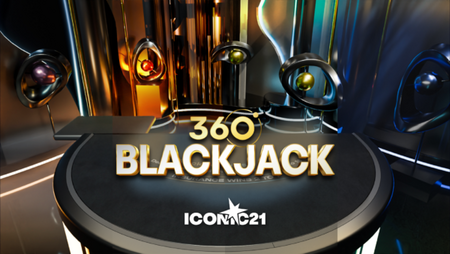To most people, 4-8 deck blackjack is simply – blackjack.
In many ways, it’s the standard and most widespread version of the game. Of course, tables can still have varying rules and features, but the core ruleset is the same one most players are familiar with.
The goal of 4-8 deck blackjack is to collect cards that add up to a total of 21 or as close as possible without going over. If the total of the cards in your hand is closer to 21 than the dealer’s at the end of the round, you win.
As usual, players take turns drawing cards. After receiving 2 cards each, players can choose to:
- Hit – draw another card
- Stand – stop drawing and end the round at the current total
- Double – double their bet but be forced to draw only 1 additional card
- Split – Turn two cards of the same rank into two separate hands
This continues until the dealer is forced to stand due to the table rules (usually at or above 17) or they go over 21. Card values are based on their rank, but every card 10 or above counts as a 10. Aces can count as 1 or 11, depending on what’s best for the current hand.
As you’ve probably guessed by now, these are simply the basic rules of blackjack. If you need a more detailed guide on the basics of the game and how to get started with it, you can check out our blackjack tutorial.
Why the Number of Decks Matters
So if the number of decks does not change the basic rules and gameplay of blackjack, what does it affect?
The most noticeable and important difference is the house advantage. All other things being equal, a game with fewer decks will have a lower house advantage. This translates into higher average RTP and better long-term profits for players.
There are several reasons why playing with fewer decks improves the RTP of blackjack. First of all, fewer cards increase the chances of hitting a natural 21, which pays 3:2 instead of the usual 1:1. Secondly, the dealer is slightly more likely to bust if you’re playing with fewer decks, which increases the player’s chances to win.
The table below shows the house advantage in blackjack based on the number of decks per shoe. Since other rules can also affect RTP, we used the same industry-standard table rules for our calculations. As such, these figures may not be accurate for all blackjack tables. They’re simply meant to illustrate the effect that the number of decks in play has on RTP.
Moreover, the number of cards in play affects the probability of achieving certain outcomes. These differences are subtle, but they can be important. In turn, these probabilities affect blackjack strategy, which we’ll discuss at length below.
So does this mean that you should play blackjack with the fewest number of decks possible?
In theory, yes. In practice, finding single-deck blackjack games in this day and age is next to impossible. Even if you do find one, they usually include other rules to compensate for the low house advantage.
As such, mastering 4-8 deck blackjack variants is the most practical approach, because that’s the version of the game you’ll most likely be playing.
Basic Strategy Overview
Blackjack strategy begins with a concept called Basic Blackjack Strategy. It’s one of the most important things you’ll need to understand if you want to get better at the game.
Basic Blackjack Strategy is the statistically optimal way to play blackjack. The idea is that every situation you can find yourself in while playing has a “correct” answer – the decision that is most likely to result in you winning and the dealer losing.
Basically, Basic Blackjack Strategy tells you when you should Hit, when you should Stand, and when Doubling or Splitting is the right move. This depends on your current hand, the dealer’s up-card, and the table rules, including how many decks are in the shoe.
The statistics behind Basic Blackjack Strategy can be quite complicated unless you already have a deep understanding of the game and the maths behind it. Thankfully, you don’t have to calculate anything yourself. Players already did so a long time ago, and their findings are typically displayed in the form of strategy charts.
Importantly, however, the best blackjack strategy depends on the table you’re playing at. Varying rules and other factors can and should affect your decision-making. Some of the factors that affect blackjack strategy are:
Pay attention to these details before picking a blackjack game to play. They are crucial for determining your strategy.
Also, remember that basic blackjack strategy does not guarantee that you’ll win, nor does it allow you to overcome the house advantage. Playing accoring to these charts simply minimizes the house edge down to around 0.5%. The strategy does not negate or overcome the casino’s edge.
Comprehensive Strategy Charts
Now that we understand what basic blackjack strategy is and why it’s so important, it’s time to get into the charts themselves. We’ll go through several possibilities based on common rule variations. Make sure to pick the right chart for the table you’re playing at.
4-8 Decks, Hard Hand Totals
We’ll start with the most basic chart that applies to most situations – Hard totals.
The chart describes what you should do if you have Hard hand totals in a blackjack game that uses 4, 6, or 8 decks.
Hard hand totals are essentially all player hands that don’t contain an Ace, or in which the Ace counts as 1. If you want a more in-depth explanation of the differences between Hard and Soft hand totals in blackjack, check out our guide to card values in blackjack.
The chart also assumes that the dealer Stands on Soft 17 because those are the most common rules these days.
- H – Hit
- S – Stand
- D-h – Double if allowed, otherwise Hit
- R-h – Surrender if allowed, otherwise Hit
4-8 Decks, Soft Hand Totals
The following chart tells us the optimal decisions to make if we have a Soft hand total.
As a reminder, Soft hand totals in blackjack are all hand totals that contain an Ace. This means that they are theoretically two totals at once, depending on whether the Ace counts as 1 or 11.
Soft hands generally allow you to play more aggressively and take risks you wouldn’t if you had the same Hard total. As such, the strategy chart looks a bit different if you’re holding an Ace.
- H – Hit
- S – Stand
- D-h – Double if allowed, otherwise Hit
- D-s – Double if allowed, otherwise Stand
Splitting Pairs
The charts provided above do not address Splitting because you can only Split if you have two cards of the same rank, i.e a Pair.
Much like any other decision in blackjack, there’s a right time to Split and a wrong time to Split. The table below shows you the optimal move in any given situation that includes a player Pair in a 4-8 deck blackjack game.
Again, the strategy chart assumes that the table rules include 4-8 decks and the Dealer Stands on Soft 17 rule.
- H – Hit
- S – Stand
- D-h – Double if allowed, otherwise Hit
- P – Split
- P-h – Split if doubling after a Split is allowed, otherwise Hit
Advanced Strategies
As the name implies, Basic Blackjack Strategy is the simplest, most elementary approach to playing blackjack well. It’s the first step every player has to master before moving on to more complex strategies.
Let’s consider some of these advanced strategies for 4-8 deck blackjack and how the deck count affects them.
Card Counting
Card counting in blackjack is widely accepted as one of the only scientifically proven methods to overcome the casino advantage.
This strategy involves keeping a count of every card that is dealt from the same shoe. This gives you information about the remaining cards, which can be used to your advantage.
The main idea of card counting is to play according to Basic Blackjack Strategy until your count tells you that the shoe contains more 10-value cards and Aces than it did after a fresh shoe was shuffled. In theory, such a shoe favors the player over the dealer, and players should use this knowledge to increase their stakes and make more aggressive decisions.
Contrary to popular belief, card counting does not require a photographic memory or complex math. Instead, most players use the Hi-Lo system. This system assigns value to cards based on their rank, allowing you to more easily track how many “good” cards have been dealt.
You can find more information about card counting and the Hi-Lo system in this guide.
However, counting cards in 4-8 deck blackjack is noticeably more difficult than with variants that use fewer decks. In fact, multi-deck shoes were first introduced into blackjack specifically as a measure against card counters.
It’s easy to understand why – multiple card decks mean that you know less about which cards are still in the shoe, undealt. Moreover, the total number of cards means that each individual card is less important for the overall state of the shoe.
In practice, this means that counting cards with multiple decks means you have to account for them. This is reflected in the difference between a Running Count and a True Count. Essentially, you have to divide your card count by the number of decks in order to calculate the actual advantage you may have.
Beyond that, 4-8 deck blackjack games also have to account for something called deck penetration. This refers to how many cards from a shoe will be dealt before the shoe is replaced with a new one, which would mean you have to start counting all over again.
The higher the deck penetration in a game of blackjack, the more cards will be played before switching to a new shoe. This means that you’re more likely to get an advantage based on the card count and that you have more time to leverage that advantage.
However, that’s many modern blackjack tables have low or very limited deck penetration. To illustrate, a deck penetration of 50% makes it almost impossible to achieve anything by counting cards. Online versions of blackjack are especially noted for having low deck penetration, so try to make a note of how many cards the dealers are dealing between two shuffles.
Betting Strategies
Besides using basic blackjack strategy, players can also control their betting. While this approach won’t necessarily result in more victories, it can certainly help you manage your bankroll and achieve more consistent returns.
- Flat Betting – Flat Betting means using the same stake in every round. It’s a simple idea, but it’s recommended for new players because it allows them to tightly control their spending and easily track wins and losses.
- Negative Progression Betting Systems – This strategy boils down to increasing your stake for the next round every time you lose. The most famous example is the Martingale, which doubles your stake whenever you lose with the goal of recouping all losses. Although effective as a money management tool, these systems can quickly become very costly if you happen to hit a losing streak.
- Positive Progression Systems – Positive betting systems increase the stake every time you win, and revert back to their starting value whenever you lose. Their goal is to maximize your profits via winning streaks. The easiest way to do so is to double your previous stake whenever you win. However, positive progression systems can have disappointing results if you don’t hit any streaks.


































 Roulette
Roulette
 Blackjack
Blackjack
 Baccarat
Baccarat
 Poker
Poker
 Sic Bo
Sic Bo
 Dragon Tiger
Dragon Tiger
 Game Shows
Game Shows  Top 5 Games
Top 5 Games  See more
See more  Roulette Casinos
Roulette Casinos  Low Limit
Low Limit  High Limit / VIP
High Limit / VIP  Exclusive
Exclusive  How to Play
How to Play  Basic Strategy
Basic Strategy  Top Tips
Top Tips  FAQ
FAQ  Blackjack Casinos
Blackjack Casinos  Baccarat Casinos
Baccarat Casinos  Bonuses
Bonuses  Poker Casinos
Poker Casinos  Game Providers
Game Providers  Sic Bo Casinos
Sic Bo Casinos  Dragon Tiger Casinos
Dragon Tiger Casinos  Credit and Debit Card
Credit and Debit Card  e-Wallet
e-Wallet  Cryptocurrency
Cryptocurrency  Bank and Checks
Bank and Checks  Pay by Phone and SMS
Pay by Phone and SMS  See more
See more  How-To Guides
How-To Guides  Top Lists
Top Lists  In-Depth
In-Depth  Strategy
Strategy  Casino & Games
Casino & Games  Insight
Insight  News
News  Promotions
Promotions 
 Guide to Live Casinos
Guide to Live Casinos  Top 10 Live Casino Tips
Top 10 Live Casino Tips  FAQ & Help
FAQ & Help  Meet The Dealers
Meet The Dealers  Our Awards
Our Awards  Responsible Gambling
Responsible Gambling 
































 ENG
ENG 



 Facebook
Facebook
 Pinterest
Pinterest
 Twitter
Twitter
 LinkedIn
LinkedIn
 Copy Link
Copy Link 





















